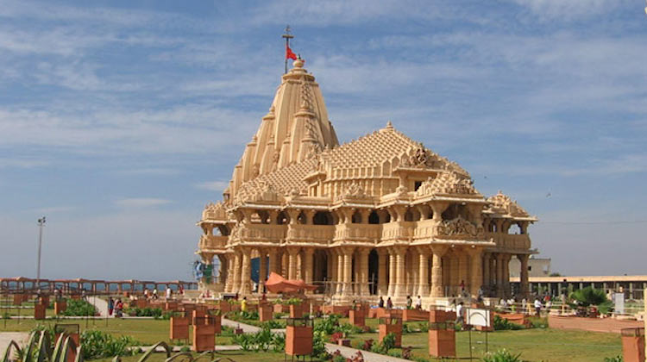
Easily one of the best-known and most popular tourist attractions in Gujarat, India, the Shree Somnath temple is also among the twelve Aadi Jyotirlinga shrines of India. Located in Prabhas Patan near Veraval in the Saurashtra region of Gujarat, this magnificent Hindu shrine has a rich history that reflects its historical importance.
The word 'Shree' is an honorific used
for a deity or holy person while 'Somnath' literally translates to the ‘Lord of
the Moon’.
Legend has it that this temple was first
constructed by the Moon God. It was destroyed on 11th March 1026 by Mahmud of
Ghazni. After multiple reconstructions and re-establishment from the 14th
century onwards, the present structure is an elegant work done by artisans from
Rajasthan under guidance from Pandit Ramsharan Sharma in 1950 as per the
original plans preserved at Anandpur. Five daily rituals are performed, a rich
kitchen and exquisite sculptures can be found in this magnanimous temple.
Somnath is located about 11 km away from
Veraval. This historic temple is located on the shore of the Arabian Sea. The
Jyotirlinga of Somnath is a single stone that has been carved out of a rock,
which stands apart from the other Jyotirlingas.
Historical Facts About Shree Somnath Temple
The temple of Shree Somnath is located
on the southern coast of Gujarat in Saurashtra. It is one of the twelve
jyotirlinga shrines of Lord Shiva, where he is believed to have appeared as a
blazing column of light. The others are Mahakaleshwar (Ujjain), Omkareshwar
(Madhya Pradesh), Bhimashankar (Maharashtra), Rameshwaram (Tamil Nadu),
Trimbakeshwar (Maharashtra), Tungnath (Himachal Pradesh), Kedarnath, Nashik,
and Kalpeshwar. It is also one of the Saptapuri (seven cities) with Varanasi,
Haridwar, Ayodhya, Mathura, Kashi, and Dwarka. The temple is one of the highly
renowned religious places in India and is counted amongst the great temples of
India.
The Somnath temple is among the first
and most important pilgrimage centers of the Hindus. Tirtha Yatra (pilgrimage)
to Somnath is considered extremely auspicious. The first Tirtha Yatra was
undertaken by Arjuna during the Mahabharata period. Apart from the rituals,
there are many legends and myths associated with the Shree Somnath temple.

It is believed that this temple of Lord
Somnath, who had lost his one tooth during the battle between gods and demons.
Then Revanta took that one tooth and kept it in a box after which the tooth
became a symbol of protection of the local people, who then established a
Siva-linga out of it. The Somnath temple is a famous pilgrimage site for all
Hindus (about 100 million).
The first evidence of the Somnath temple
dates back to the 6th century BC. This period can be identified by historians
with certainty since the inscription found at the entrance gate records a
donation in 515 AD during Gupta rule. The words used in this inscription are
Sanskrit and Pali, which establishes that a mixture of both languages was used
here for writing purposes.
The temple was looted and destroyed by
the Afghan ruler Mahmud of Ghazni in the 11th century. In 1311, the temple was
looted again by Alla-ud-din Khilji. The temple is believed to be built before
the birth of Mahavira, 24 incarnations of Vishnu, in Jain mythology. Now it's a
protected monument under the Archaeological Survey of India. There are many
historical references to this temple but there are no historical references to
any other temple in the world which has been destroyed and rebuilt 16 times, at
different periods and by different rulers. These 16 temples were built one
after another on the same spot where Shree Somnath Mahadev Temple stands today.
The Somnath temple is a massive
structure of ancient India. Surrounded by the Arabian Sea, it has been
mentioned in the books of history and mythology. The temple was built during
the reign of Bhimdev I, who was the founder of the Chalukyas dynasty. The
Chalukyas rule was started with a capital at Anahilavada (now Patan, Gujarat),
and then established at Vallabhi before moving to their final capital at
Siddhapur.
Till 1528, when Junagadh was conquered
by the Gujarat Sultan Sher Shah Suri, the temple had remained intact. But soon
after that incident, it underwent several destructions from different invaders
such as Alauddin Khalji, Allauddin Khilji, and Mahmud Begada.

History says that whenever this temple
was destroyed, it was not only reconstructed with bigger glory but also became
one of the most famous temples in India at that time.
Darshan Timings
Morning : 7.30
AM to 11.30 AM
Afternoon : 12.30 PM to 6.30 PM
Evening : 07.30 PM to 10.00 PM
Temple Closing Time 10.00 PM
Aarti Timings
7.00 AM, 12.00 Noon, 7.00 PM
During Aarti, Devotees will not be
allowed
How to Reach Somnath Temple – Location
The Somnath temple is a Hindu temple in
Prabhas Patan, Gujarat, India. It is located near Veraval in Saurashtra.
Veraval Somnath is connected to rail and
road infrastructure in Amdavad.
Ahmedabad is 465 kilometers away from
Somnath.
Ahmedabad is connected to all important
locations by rail, road, and air.
Jet Airways currently operates daily passenger
flights from Bombay to Diu, except for Thursday.
Somnath and Diu are connected by road (95 km).
Shree Somnath Mandir is one of the
ancient and famous temples all over India. It is a symbol of faith and peace
for both Hindus and Muslims. According to devotees, this is also referred to as
"Shakti Peeth" which gives people peace from mind and heart pains.

.jpg)








No comments:
Post a Comment